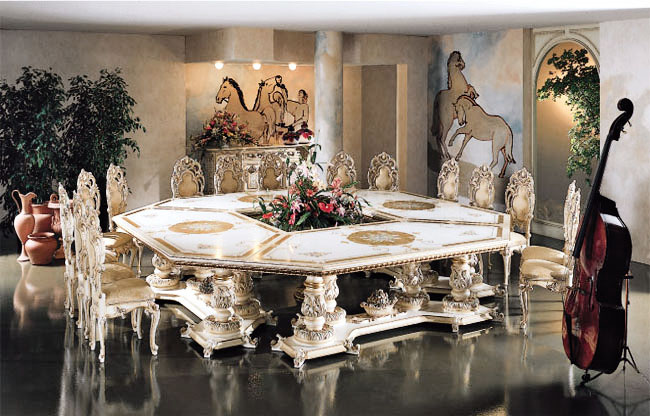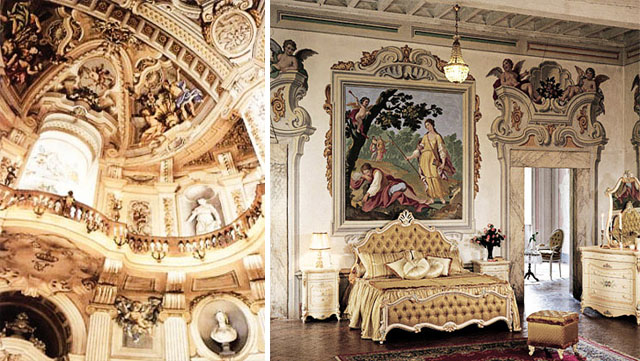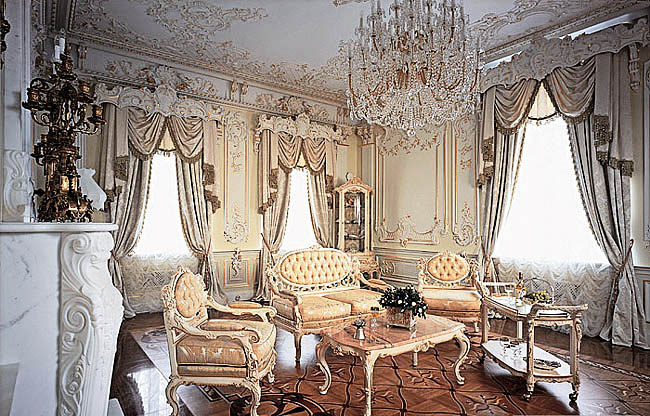| Baroque |

The middle XV — the end of XVI centuries is the great geographical time and is natural-discoveries (Magellan has made the first global cruise, Columbus has peddled old stuff, Kopernik movement of the Earth round the sun …), which have led to painful changes of outlook, to unexpected turns of human thought. Now representations of people about the flat Earth are completely crushed by the scientists, who have proved that by its form is the sphere. It was from what to come to confusion. On this soil there was the irrevocable psychological break, which has become a basis of the future epoch of baroque.
Baroque style XVI-XVIII centuries (ital. barocco — freakish) has arisen in Rome and has grown on forms of Classicism of Renaissance. Its brightest samples of architecture are created in Italy, Spain, Portugal, Southern Germany, Czech Republic, the Spanish and Portuguese colonies in Latin America (in these countries the Catholic church had the big power). Magnificent baroque has been urged to glorify the absolute power of the monarch and to glorify church.

The founder of architecture of Baroque style is Frenchman Charles Lebren — the founder of a palace complex in Versailles, and in painting Michelangelo — a list of a plafond of the Sikstinsky chapel in Vatican, a lobby of library the Dignity — Lorentso in Florence and an interior of the Chapel of Medici. In its works return to cultural wealth and opening of new forms is traced. This ingenious artist didn't submit to standards, represented figures not by rules of plastic anatomy. Lorentso Bernini, who has created the St Peter's place, set of sculptures and fountains, and Franchesko Borromini (San Karlo church alle as Kvatro the Fountain and Sant — Iwo alle the Sapiens) are considered as the most unsurpassed architects of the Italian baroque.

Features of baroque were possible to name dynamism, curvature of lines, ponderousness of forms, aspiration to the maximum expressiveness, prevalence of a vertical over a horizontal, decorative splendor and sharply complicated decor. The architecture of baroque showed richness and prestige of the owner.
In Baroque style in interior was used gold, silver, copper, a bone, marble, various breeds of a tree, a mosaic, facing by an interline interval. As decorative elements applied mirrors, a sculpture and painting (Rubens and late Rembrant), walls tightened expensive fabrics, decorated a stucco molding. The basic theme for landscape painting were: city landscapes, the sea, the French genre scenes with interiors of baroque palaces. During this period of time the big development have received: porcelain, a mirror, nacre, an ivory, a stone mosaic. Circles and ovals are replaced by difficult spirals, smooth surfaces — bent and convex. A carving of curling stalks, bowls, garlands. For the first time there are rooms with a covering of walls in uniform style with furniture.
In baroque furniture are traced the difficult over gilded carved elements, soft the sitting, upholstered with expensive bright fabrics and plentifully decorated with a fringe. Furniture’s often applied such refined reception as inversion — alternation of elements, in an oak place used a soft nut, more suitable for a carving and polishing, used the bronze over gilded overlays. The wavy lines, the bent legs, the varnished furniture, dressers enter into a fashion with drawers, the floor watch decorated with bronze, two-folding cases, show-windows, pedestals for sculptures. During this epoch there were furniture complete sets, armchairs with strongly unbent backs and the extended seats for the extended feet. Sofas are similar to the armchairs connected with each other which top did wavy. At tables the massive table-top from a mosaic and color marble, the round form is observed. Edges of tables are decorated by a carving and inlaid, in the form of goals of rams, lions or female figures. During an epoch of baroque the bed has got the form of a tent with an abundance of curtains and draperies.
The Spanish baroque is impregnated by decorative effect Spanish — Mauritian architecture and local folklore traditions. The architecture of the Spanish baroque barbarous and fantastic, it is oversaturated by a baroque decor. In this style all is possible to a burlesque.

Russian baroque has arisen in the end of XVII century is time named «Petrovsky baroque». The first quarters of XVIII century, «mature Russian baroque» or «Elizabethan baroque». New way of life of Russian nobility and an imperial court yard, demanded palaces in style of the European baroque where it was possible to give rich dinners, to arrange magnificent receptions, balls. Peter I, Elizabeth Petrovna's daughter, tended to forms of the sated Italian baroque. In days of its board the best samples of the Russian baroque, differing from Italian have been created by absence of religious mysticism. Franchesko Bartolomeo Rastrelli, the outstanding architect, has constructed for Elizabeth a palace in Tsarist Village. Its other constructions are the Winter palace and Smolnyj a cathedral. In Rastrelli's have incorporated the original architecture composition methods of the European Classicism, Baroque and the French Rococo.
The term should be quoted «Russian baroque», since it is accepted not by all. This solemn and joyful style, carrying out the function, resisted to the Middle Ages. From here its moderation alien to the western Baroque. Baroque style remained a turning-point in the history of development of world art.





